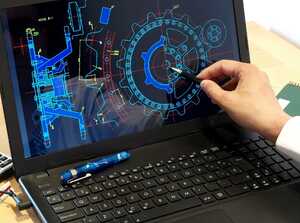Rapid Prototyping For Software Engineers: A Complete Guide
Rapid prototyping (RP) is a technique that has quickly become a favorite in the design and engineering communities. Essentially, RP allows designers and engineers to create digital models of their ideas quickly and easily. This can be incredibly helpful in making decisions about design, product development, and more. In this blog post, we’ll look at what RP is, how it works, and some of its types.
What is rapid prototyping?
Simply put, rapid prototyping is a technique that allows you to create a working model of a product or concept very quickly. While the design process is accomplished using CAD (Computer Aided Design), the physical model is done via an additive process or 3D printing.
Rapid Prototyping can be divided into different categories based on the process and the technique used: Additive manufacturing (3D-printing) and Subtractive manufacturing.
Because of its low cost, great accuracy, and material compatibility, 3D-printing is the most popular technique for prototyping (especially for a low volume of parts). However, for material versatility and faster production, subtractive manufacturing works best.
Let’s understand the two now.
Additive Manufacturing
3D printing is a process that takes CAD models or digital 3D designs and turns them into physical objects. There are various processes involved, with the process typically involving computer-controlled stack printing of additional materials.
Additive manufacturing processes
Selective Laser Sintering (SLS)
SLS is an additive manufacturing process first patented by Carl Deckard. The prototype is made from layers of powder that are heated and sintered by a powerful laser. SLS is slightly inexpensive, involves little time and work, and has a high output rate.
Good for: Making plastic or metal prototypes
SLA (Stereolithography)
Stereolithography is one of the first and most widely used commercial 3D printing processes. This method transforms the photosensitive liquid into 3D solid plastics using UV light. These layers are created from the 3D CAD model’s two-dimensional cross sections and are managed by the .STL file extension.
Good for: Top-notch prototypes, intricate geometrical shapes, and master patterns for vacuum casting.
Fused Deposition Modelling (FDM)
The thermoplastic filament is used in FDM printers to make 3D objects. The filament is then heated up inside a printing nozzle’s barrel. The resin is heated to a liquid state and then applied layer by layer. However, an item must be translated into a 3D printer-compatible format, usually an .STL format before it can be printed.
Good for: Consumer goods manufacturing and automotive industries.
Laminated Object Manufacturing (LOM)
In LOM, feed rollers spread materials like plastic, paper, or metal across a build platform. A computer-controlled laser or other cutting tool carves out the pattern on each layer. The build platform then sinks by one-sixteenth of an inch (normal thickness of one layer); a new laminate is placed on top, and the procedure is repeated.
Good for: Affordability.
Digital Light Processing
With digital light processing, the resin is cured using a more traditional light source, but it also necessitates support structures and post-build curing. The method is rapid and allows for the use of a shallower photo resin reservoir, lowering expenses further. The completed object has outstanding dimensional tolerances and surface polish, similar to SLA.
Good for: In-depth detailing and higher surface quality.
Binder Jetting
In this procedure, liquid binding agents are sprayed through nozzles to unite powder particles and create one item layer. The powder is added, dispersed, and crushed by a roller; then, the binder is added layer by layer. Powder and binder are finally layered to produce the portion. When complete, the component is baked to remove the binding agent that has combined the powder with the final result.
Good for: manufacturing one or more pieces simultaneously.
Subtractive Manufacturing
A large piece of material is carved into the desired form using grinding, turning, or milling. You can create designs, prototypes, and finished products with subtractive manufacturing.
Subtractive manufacturing process
CNC Rapid Prototyping
The CNC machining equipment uses computerized controls to monitor the movements. It can move as slowly or quickly as needed without any limitations due to alternative prototyping processes.
First, a 3D CAM model of the finished product is made. The finished model is then transformed into a CAD design. Computer-Aided Design (CAD) files, as opposed to Computer-Aided Manufacturing (CAM) files, are immediately understood by CNC machines since they contain the machine’s operating instructions.
Good for: CNC Milling Prototyping works best for faster production and when using diverse materials.
Summing up
With the ability to create working models of your designs in minutes, you can avoid countless hours of development time and get your invention to market faster than ever before. In this comprehensive guide, we covered everything from how it works to the various techniques that are in practice. You may even use a prototype creator if you are not adept at it.



